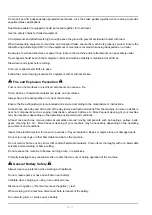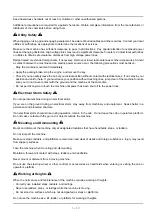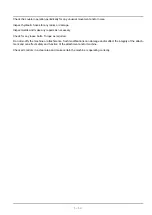
When using auxiliary batteries or connecting booster cables to start the engine, use the procedure shown in the
operator’s manual. Do not short across terminals.
Follow the manufacturer’s instructions when storing and handling batteries.
Battery post, terminals, and related accessories contain lead and lead compounds. Wash hands after handling. This
is a California Proposition 65 warning.
Battery acid causes burns. Batteries contain sulfuric acid. Avoid contact with skin, eyes, or clothing. Antidote (ex-
ternal): Flush with water. Antidote (eyes): flush with water for 15 minutes and seek medical attention immediately.
Antidote (internal): Drink large quantities of water or milk. Do not induce vomiting. Seek medical attention immedi-
ately.
Keep batteries out of reach of children and other unauthorized persons.
Reflectors and Warning Lights
Reflectors may be added to the machine.
Flashing amber warning lights must be used when operating on public roads.
Operator Presence System
Your machine is equipped with an operator presence system to prevent the use of some features while the operator
is not in the operator’s seat.
Never make adjustments to the seat while the machine is in motion.
The operator presence system should never be disconnected or bypassed.
If the system is inoperable, the system must be repaired.
Seat Belts
Seat belts must be worn at all times.
Seat belt inspection and maintenance:
• Keep the seat belts in good condition.
• Keep sharp edges and items than can cause damage away from the belts.
• Periodically check belts, buckles, retractors, tethers, slack take-up system, and mounting bolts for damage and
wear.
• Replace all parts that have damage or wear.
• Replace belts that have cuts that can make the belt weak.
• Ensure the bolts are tight on the seat bracket or mounting.
• If the belt is attached to seat, ensure the seat or seat brackets are mounted securely.
• Keep seat belts clean and dry.
• Clean belts only with soap solution and warm water.
• Do not use bleach or dye on the belts, as this can weaken the belts.
Operator Protective Structure
Your machine is equipped with an operator protective structure, such as: a Roll Over Protective Structure (ROPS),
Falling Object Protective Structure (FOPS), or a cab with ROPS. A ROPS may be a cab frame, a two-posted, or
four-posted structure used for the protection of the operator to minimize the possibility of serious injury. The mounting
structure and fasteners forming the mounting connection with the machine are part of the ROPS.
The protective structure is a special safety component of your machine.
1-8



































